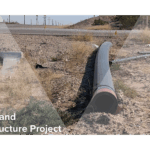
Phase 1 Environmental Site Assessments (ESAs) play a crucial role in property transactions. These assessments provide valuable information about the environmental conditions of a site, helping buyers, sellers, and lenders make informed decisions regarding real estate transactions. In Norman, Oklahoma, where industrial activities and development are prevalent, Phase 1 ESAs are even more critical to ensure the safety and sustainability of properties. This article will explore the significance of Phase 1 ESAs, the process of conducting them in Norman, interpreting the results, legal and regulatory aspects, and the role of environmental professionals in these assessments.
Understanding the Importance of Phase 1 Environmental Site Assessments
Before delving into the specifics of Phase 1 ESAs, it is essential to grasp their overall importance. These assessments are conducted to identify potential environmental contamination on a property. By doing so, they help protect the interests of all parties involved in a real estate transaction by uncovering any existing or potential risks.
Furthermore, conducting a Phase 1 ESA is not only a prudent business decision but also a legal requirement in many cases. Lenders often require a Phase 1 ESA before approving financing for a property, as it helps mitigate their risk and ensures compliance with environmental regulations.
The Role of Environmental Site Assessments in Property Transactions
Phase 1 ESAs are an essential part of property transactions because they provide an overview of the environmental conditions of a site. They help buyers and sellers determine if there are any environmental risks that may impact the property’s value or pose liability concerns. Furthermore, they allow both parties to negotiate potential mitigation measures or adjustments to the purchase price based on the assessment results.
Key Components of a Phase 1 Environmental Site Assessment
A Phase 1 ESA consists of several key components that work together to provide a comprehensive evaluation of a property. These components include a site inspection and evaluation, historical review, and interviewing relevant individuals.
The initial site inspection involves a detailed examination of the property to identify any visible signs of contamination or potential sources of pollution. This includes assessing existing buildings, storage tanks, and outdoor areas where hazardous substances might be stored or used.
The historical review delves into the past uses of the site and neighboring properties, identifying any potentially contaminating activities that may have occurred in the past. This information helps in understanding the potential risks associated with the site.
Interviewing current and past property owners, as well as individuals familiar with the site’s history, is another crucial component of a Phase 1 ESA. These interviews can provide valuable insights into past activities and potential environmental concerns that may not be evident during the site inspection or historical review.
The Process of Conducting a Phase 1 Environmental Site Assessment in Norman
Initial Site Inspection and Evaluation
When conducting a Phase 1 ESA in Norman, environmental professionals start with an initial site inspection and evaluation. This involves physically examining the property and documenting any noticeable signs of contamination, such as spills, leaks, or improper storage of hazardous materials.
The environmental professional will also evaluate the property’s surroundings to identify any potential sources of contamination, such as nearby industrial activities or hazardous waste facilities.
Historical Review of the Site
In Norman, a thorough historical review is critical to understanding a property’s environmental history. This review typically includes researching historical records, aerial photographs, topographic maps, and city directories to gather information on past land uses and activities that may have caused contamination.
Local archives and libraries may hold valuable information about previous industrial activity or known environmental issues in the area, providing essential context for the Phase 1 ESA.
Interviewing Current and Past Property Owners
Interviews with current and past property owners are conducted to gather firsthand information about the site and its history. These interviews can reveal valuable insights into past uses, storage practices, and any prior knowledge of potential contamination or environmental issues.
Environmental professionals will typically ask specific questions to elicit information about any previous chemical spills, fuel storage, hazardous waste disposal, or other activities that could have resulted in environmental contamination.
Interpreting the Results of a Phase 1 Environmental Site Assessment
Identifying Potential Environmental Risks
Once the Phase 1 ESA is complete, the environmental professional will compile the findings and assess the potential environmental risks associated with the property. This evaluation includes considering the likelihood and severity of contamination, as well as the proximity of potential contaminating activities.
If potential risks are identified, further investigation or remediation may be recommended to fully assess the extent and impact of the contamination.
Recommendations for Further Investigation or Remediation
Based on the assessment results, the environmental professional will provide recommendations for any additional investigation or remediation that may be necessary. This may involve conducting a Phase 2 ESA, which includes sampling and testing soil, groundwater, or building materials to determine the presence and extent of contamination.
If contamination is confirmed, remediation measures may be recommended to address the environmental risks and bring the property into compliance with relevant regulations.
Legal and Regulatory Aspects of Environmental Site Assessments
Federal and State Environmental Laws
Phase 1 ESAs are guided by various federal and state environmental laws and regulations. The Comprehensive Environmental Response, Compensation, and Liability Act (CERCLA), commonly known as Superfund, is a federal law that addresses hazardous substance releases and establishes liability for cleanup costs.
Additionally, the Resource Conservation and Recovery Act (RCRA) regulates the management of hazardous waste and protects human health and the environment from potential harm.
At the state level, Oklahoma has its own environmental regulations that must be considered during the Phase 1 ESA process. These regulations can vary depending on the nature of the property and local environmental conditions.
Liability Issues in Environmental Site Assessments
Liability is a key concern in environmental site assessments, as potential contamination can lead to legal consequences for property owners. Conducting a Phase 1 ESA helps identify and manage these risks, allowing prospective buyers or property owners to make informed decisions based on the assessment results.
By conducting a Phase 1 ESA in accordance with industry standards, property owners can potentially avoid liability for contamination discovered after a transaction has taken place.
The Role of Environmental Professionals in Phase 1 Assessments
Qualifications and Responsibilities of Environmental Professionals
Environmental professionals play a crucial role in conducting Phase 1 ESAs. They are individuals with specialized knowledge in environmental science, engineering, or a related field.
These professionals are responsible for guiding the Phase 1 ESA process, adhering to applicable regulations, and providing objective and accurate assessments of environmental risks.
Selecting the Right Environmental Professional for Your Assessment
When conducting a Phase 1 ESA in Norman, it is essential to select an environmental professional who is experienced and knowledgeable in local environmental conditions and regulations.
Consider factors such as the professional’s qualifications, industry reputation, and track record of successfully completed Phase 1 ESAs.
Furthermore, ensure that the selected environmental professional follows established industry standards, such as those outlined by the American Society for Testing and Materials (ASTM) International, to ensure the quality and accuracy of the assessment.
In conclusion, Phase 1 Environmental Site Assessments are vital in the real estate industry, particularly in a city like Norman, Oklahoma, where industrial activities are prevalent. These assessments provide valuable information about the environmental conditions of a property, allowing stakeholders to make informed decisions regarding property transactions.
By understanding the importance of Phase 1 ESAs, the key components of the assessment process, interpreting the assessment results, and considering the legal and regulatory aspects, property owners can effectively manage environmental risks and protect their interests. Working with qualified environmental professionals is paramount to ensure accurate and reliable assessments, providing confidence in the assessment results.
Ready to ensure your property in Norman is environmentally sound and compliant with all regulations? Look no further than ESE Partners. Our team of expert environmental engineers and scientists specialize in Phase 1 Environmental Site Assessments, offering innovative solutions tailored to the unique challenges of your business. With a commitment to improving community quality of life and a track record of delivering honest, quality-driven results, we’re here to help you responsibly move your business forward. Request A Proposal today and partner with a firm that understands the broad complexity of environmental challenges.








